During 1968, the total number of deaths registered in Scotland was 63,311: male deaths numbered 32,146, and 31,165 were female. The ‘Annual Report of the Registrar General for Scotland’ records that the cause of deaths varied from illness to accidental death and old age. It also reports that 17 deaths that year were attributed to a ‘cataclysm’ which occurred during severe storms in the new year, although the total was later confirmed to be 21.
On the night of Sunday 14 January and morning of Monday 15 January 1968 hurricane force winds hit the city of Glasgow before travelling across central Scotland. The impact of the gale was felt particularly across the Central Lowlands, but southern Scotland from Tiree to the Firth of Tay and Kintyre to Edinburgh was also affected. Winds as strong as 130 mph were recorded by the Meteorological Office.
The damage was catastrophic. No-one had been warned about the impending storm and the emergency services were unprepared. Originating in the Bahamas, the storm was expected to push past the west coast of Scotland making little contact with the mainland. When it met another weather front, however, it changed direction and headed up the River Clyde. In addition to claiming the lives of 21 people, more than 100 were injured. Around 250,000 homes were damaged across Scotland, resulting in almost 2,000 people becoming temporarily homeless.
The storm, named Hurricane Low Q, arrived during the night, when most people were at home in bed, blowing in house and shop windows, tearing roofs off buildings and trees from the ground. Cars were crushed by falling masonry and chimney stacks fell straight through tenements. It remains one of the greatest natural disasters in Scotland.
In flats in Dumbarton Road, Glasgow, Annie Best and her 4 year old daughter Angela, who had travelled from England to attend Annie’s mother’s funeral, were sleeping when the storm hit. Next door slept Janet Gowran and her 10 year old daughter Nancy. All four died when a chimney stack fell through the roof. It took rescuers 12 hours to find their bodies in the basement of the tenement.
Image
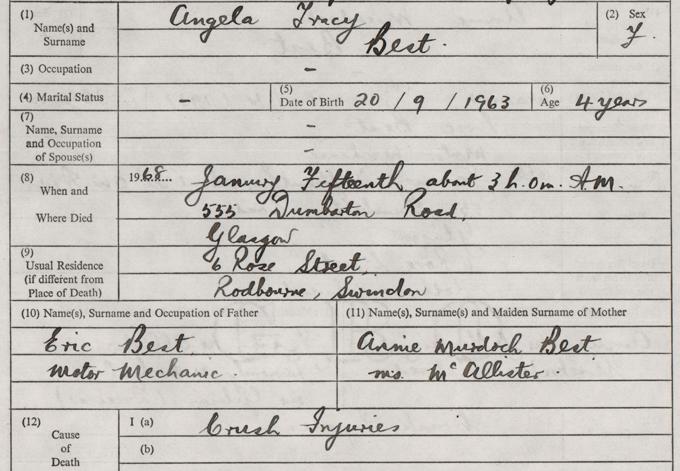
Death entry of Angela Best
National Records of Scotland, Statutory Register of Deaths, 1968, 644/6 75
Falling chimney stacks resulted in other deaths that evening, including one man who was killed in bed when a chimney fell through his roof in Willowpark Street, Glasgow, and another in Wellfield Street. A 5 year old girl was killed and her sister was seriously injured when a chimney head crashed through a roof in Port Street, Glasgow. Four month old Isobel Hunter miraculously survived, however, when a chimney fell through the roof of her home in Dumbarton. It hit her pram which fell through the floor. Firemen, police and neighbours dug for an hour through rubble to find her smiling up at them.
In a tragic turn of events, Hugh Timmoney, aged 24, died when a tree was blown into his car as he drove his wife Evelyn to hospital to give birth to his son Andrew. Another man, who had taken his wife to the maternity hospital before the storm hit, returned home to find his flat had collapsed.
Image
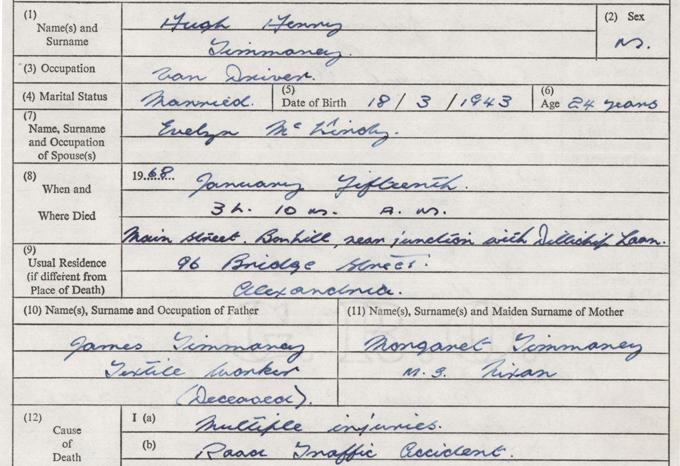
Death entry of Hugh Timmoney
National Records of Scotland, Statutory Register of Deaths, 1968, 493/18
Newspapers also reported on the desperate conditions at sea for ships. In the North Sea 19 men in the rig ‘Sea Quest’ were tossed around by 25 feet waves and two newly built vessels, one a 15,000 ton refrigerated ship, broke away from their moorings. Joseph Ayre, the ship’s cook, Ewen Morrison a deckhand, and Matthew Hanton, a boiler-man, all drowned when the Clyde Port Authority dredger ‘Cessnock’ capsized and sank 300 yards off Princess Pier, Greenock.
Image
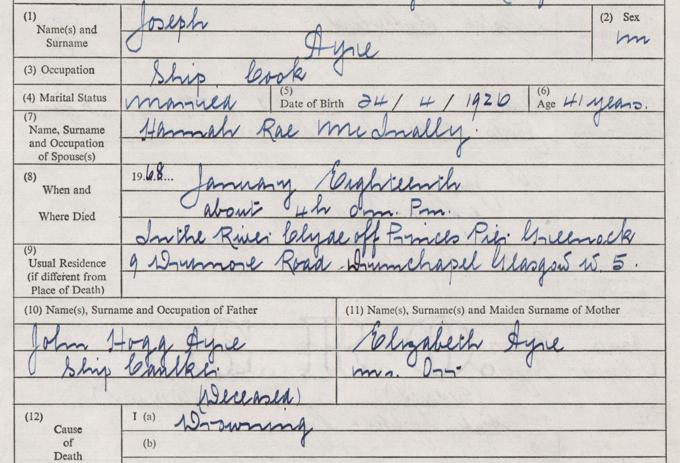
Death entry of Joseph Ayre
National Records of Scotland, Statutory Register of Deaths, 1968, 564/118
Lee Meow Kua was a Malaysian physiotherapist living in Glasgow. She died at the Western Infirmary on the morning of 15 January from crush injuries she sustained in the storm.
Image
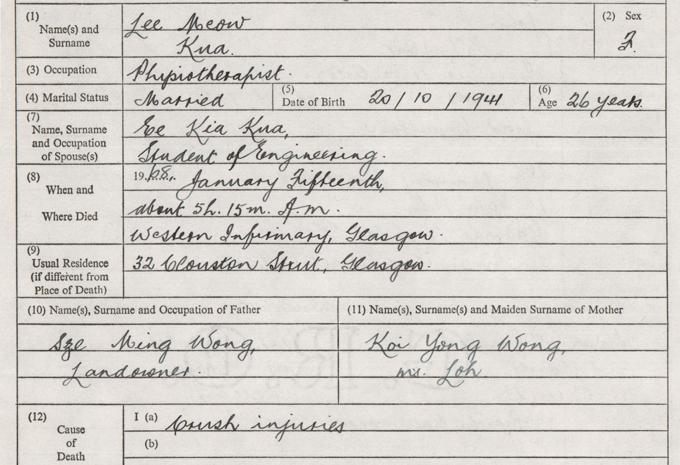
Death entry of Lee Kua
National Records of Scotland, Statutory Register of Deaths, 1968, 645/3 75
In Edinburgh, William Anderson, a printer’s packer, and his wife Elsie died in their home at 7 Northcote Street, Edinburgh, when masonry fell through their bedroom. In the following months, the ‘Glasgow Herald’ reported that fourteen families who had lived in the four-storey tenement with the Anderson family were too afraid to return to the building because of its unsafe condition after the storm.
Image
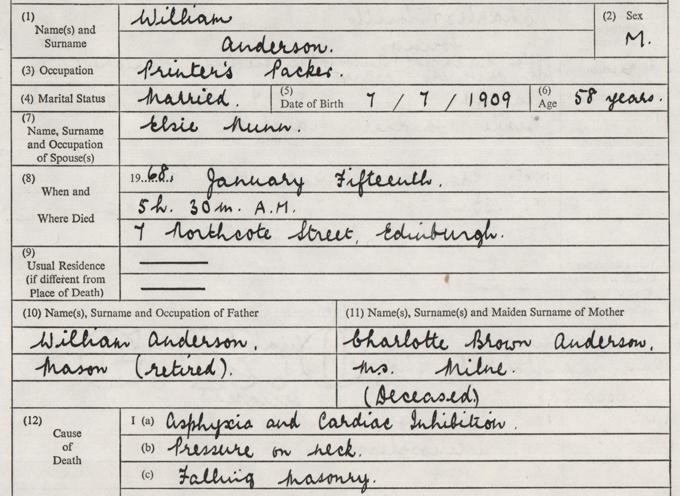
Death entry of William Anderson
National Records of Scotland, Statutory Register of Deaths, 1968, 685/1 84
Other areas outside Glasgow and Edinburgh were also affected by the hurricane. In Fife, which suffered damage to 4,500 local authority properties and 2,000 private homes, the Reverend Alexander Cameron and his wife were seriously injured when a chimney head crashed through the roof of their house. In Dundee Mr and Mrs Alexander Clark woke when their living room ceiling fell in after two chimney heads crashed through their house.
Ex-Prime Minister Edward Heath commented on the tragedy saying ‘it is hard to visualise what happens when three tonnes of solid masonry falls through a roof, it goes through the roof, the next floor and the next, creating a bomb crater in the basement, leaving only death behind it.’
The Queen sent a message to the Secretary of State for Scotland sending ‘our deepest sympathy to those who have been bereaved, and to those who have suffered in the devastation.’
Those left alive and uninjured faced the task of rebuilding their homes. The storms highlighted the poor conditions of many properties across Scotland, particularly in Glasgow, where 52 buildings had collapsed in the hurricane and almost 29,000 roofs were damaged. Many thousands of properties were considered to be unfit for habitation or became irreversibly sub-standard in their condition. For over a year after the storm, a lack of workmen available to mend the damaged properties left families to live with tarpaulins over the holes in their roofs. The total cost of damage to property across Scotland was £30 million.


